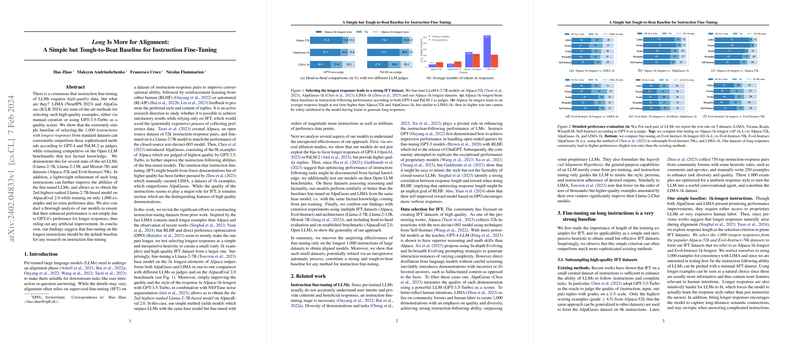Introduction
Instruction fine-tuning (IFT) of LLMs is a critical process that shapes these models to better adhere to human directives, enhancing their conversational capabilities and task performance. While advanced techniques such as LIMA and AlpaGasus leverage carefully curated high-quality examples to guide this process, the paper in question challenges the notion that IFT necessitates complex example-selection mechanisms.
Baseline Methodology
Research has emphasized the selection of high-quality IFT examples, but this paper submits that selecting examples according to their response length – a straightforward and cost-effective method – can not only rival, but also outstrip more nuanced strategies. The authors extract 1,000 lengthiest instruction-response pairs from standard datasets like Alpaca-52k and Evol-Instruct-70k and demonstrate that models fine-tuned on these selections consistently outpace sophisticated methods, such as those deployed in LIMA and AlpaGasus, in head-to-head evaluations. These findings remain robust even when tested against alternative LLM judges like GPT-4 and PaLM-2.
Comprehensive Evaluation
A rigorous assessment across multiple datasets and LLMs (including Llama-2-7B, Llama-2-13B, and Mistral-7B) confirms the efficacy of the simple baseline. In particular, fine-tuning on the 1,000 longest responses often led to significantly better performance than more complex selection methods. Furthermore, a refined version of the longest-instruction dataset was created through a process resembling introspection and subsequently tested to show enhanced performance, affirming its value as an adept baseline for IFT research.
Implications and Analysis
In an unexpected turn, the findings suggest refining models on lengthy instructions may be beneficial beyond sheer alignment. When tested on factual knowledge benchmarks from Open LLM, the fine-tuned models generally maintained or improved factual accuracy, indicating that IFT can enhance factuality if the training dataset is sensibly selected. These results suggest an intricate relationship between the characteristics of the IFT dataset and the resulting model's abilities.
In essence, the paper overturns prior assumptions regarding IFT dataset construction, advocating for the potential of simple heuristics like response length as a baseline standard. The implications of these results are considerable and may prompt a re-evaluation of current methods in developing future LLMs.
